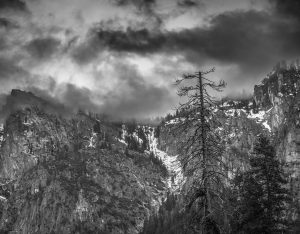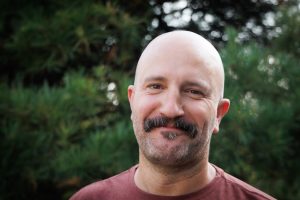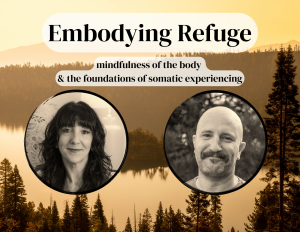In late 2018 and early 2019, a handful of us started writing what we hoped might become supplemental literature for the Refuge Recovery program. While each of us had different personal reasons for wanting to take part in the project, discord regarding the primary Refuge Recovery text served as the broader context.
Loosely, the goal was to offer a practice guide framed around the triple gem – the Buddha, the Dharma, and the Sangha – using language that more closely aligned with familiar understandings of the Buddhadharma. Personally, I wanted members who were first introduced to the Dharma in their recovery meetings to have ease when deciding to practice in more traditional Dharma communities. For example, I wanted to see the four Noble Truths presented in something more akin to their original language. Again, each contributor to the project brought their own reasons for taking part.
Everyone assumed different tasks for the text. I opted to write the “Buddha” section, while others took up remaining sections. Some of us were part of the process from start to finish. Some of us were openers and some of us were finishers. At some point, we realized that what started out as supplemental literature was going to become a stand alone text for the new Recovery Dharma program. A first edition was published in 2019 and a second edition, which includes personal stories, came out in 2023.
What follows is one of my early drafts for the ‘Buddha” section. I have opted to leave “Refuge Recovery” in the text because that is how it was originally written.
“The Buddha”
Refuge Recovery is a Buddhist-inspired path of recovery, yet many of us who find it are unfamiliar with Buddhism. There are unfamiliar words, unfamiliar concepts, and unfamiliar ways of looking at the world. It can be intimidating and uncomfortable sitting in a room with others who are using words like karma, dharma, sangha, and Buddha. If you have felt this way, do not fret. You are not alone. It is our hope that, by the time you are finished reading through this book, you will be comfortable in understanding the fundamentals of Buddhist practice and how we apply them to our recovery.
Most of us come to Refuge Recovery, initially, with one goal in mind: to stop the suffering and destructive behavior that got us here in the first place, whether that is drinking, using drugs, stealing, eating, gambling, sex, codependency, technology, or other process addictions. As newcomers, most of us would be satisfied with simple damage control; that is, we want to stop harming ourselves or others in particular ways.
So what does the Buddha have to do with all of this?
There are two ways in which we use the word Buddha, which means “awakened.” First, it is the title given to a person named Siddhartha Gautama, a man who lived in modern-day Nepal and India roughly 2,600 years ago. After many years of meditation and ethical practice, he discovered a path that leads to the end of suffering. After this discovery, which we may choose to call liberation or awakening, Siddhartha came to be known as the Buddha.
The second usage of the word Buddha follows from the first. Buddha can refer to not only the historical figure but also to the ideal of awakening, the fact that each of us has within ourselves the potential to awaken to the understanding that the original Buddha did. When we take refuge in the Buddha, we take refuge not in Siddhartha as a man, but in the fact that he was able to find freedom from his suffering. He was human just like us, experienced suffering just like us; he found liberation from it, and so can we.
In order to understand the nature of this awakening and what it is we in Refuge Recovery are aiming at, it helps to know something about the life of the man named Siddhartha Gautama.
There are numerous versions of the traditional story of the Buddha. Some of them are very mythical, some of them are more down to earth. It has been said that Siddhartha was a prince, that he was wealthy, and that he was born into privilege, sheltered from much of the suffering of the world. Realizing that suffering seemed to be an inherent part of life itself, Siddhartha wondered if there was a way to find an end to it. At that point, he came in contact with a wandering ascetic. A holy man. A person who had given up the material world in order to find freedom from suffering through meditation, ethical behavior, and renunciation. Illness, aging, death, and renunciation. These four things, which are sometimes referred to as the Divine Messengers, stirred within Siddhartha the motivation to take up the holy life himself.
Whether one chooses to believe the specifics about the traditional story of Siddhartha Gautama is irrelevant. What matters most is that, despite leading a life of relative ease, Siddhartha still found that he experienced a persistent amount of suffering and dissatisfaction. Wealth did not prevent it. Comfort did not prevent it. Pleasure did not prevent it. This persistent dissatisfaction with life, whether dramatic or subtle, is what we refer to as dukkha. Most of us can relate.
Leaving behind his family and the materially comfortable life of a prince, Siddhartha joined the wandering ascetics of his day. He studied with various meditation teachers and took up a moral life. In most instances, Siddhartha became so adept at concentration meditation that he outdid his own teachers and was asked to become a guru himself. Siddhartha always declined the invitation to teach because, despite his training, he was yet to find liberation from dukkha. He moved on to different teachers and experimented with new methods of practice.
For seven years, Siddhartha wandered with ascetics and learned from different teachers. He eventually found himself in the company of five wanderers, with whom he decided to practice extreme forms of asceticism. He sat in extremely uncomfortable postures for long periods of time. He slept very little. He ate very little. He even tried breathing very little. He thought that, since material comfort hadn’t brought about an end to suffering, perhaps the opposite of material comfort would. But it didn’t. Pushed to the brink of death, Siddhartha abandoned the idea of extreme asceticism.
In some versions of the story, Siddhartha just decided to eat food like a normal person again. In others, he was nursed back to health by a compassionate woman in a nearby village. Either way, Siddhartha realized that the extremes of sensuality and denial of sensuality had gotten him nowhere nearer to liberation. Neither material comforts nor material renunciation had alleviated his suffering. So he set off on his own to meditate. Sitting beneath a pipal tree, now known as a Bodhi tree, he committed himself to meditation until he had discovered the path that leads to the end of suffering. Fortunately for him and for all of us, he did just that.
During a single night of meditation, Siddhartha Gautama experienced three layers of insight which led to his awakening. During the first watch of the night, Siddhartha experienced what is called in the ancient texts the recollection of his past lives. We can take this to mean that he came to understand the way that the law of karma had operated in his own life and how every previous moment had brought him to that very place.
During the second watch of the night, Siddhartha experienced an expanded understanding of the law of karma, including all beings within this insight. He saw how skillful actions lead to beneficial results, and how unskillful actions lead to unwelcome results. Siddhartha saw that no beings, whether great or small, are exempt from the law of cause and effect.
During the third watch of the night, Siddhartha experienced an understanding of dependent arising, the unique Buddhist idea that all things are conditioned and dependent upon all other things for their very existence. Having developed this final insight, Siddhartha Gautama also came to understand the Four Truths and Eightfold Path that we have come to recognize as the foundation of Buddhist practice and, hence, Refuge Recovery.
If you don’t understand the law of karma, dependent arising, the Four Truths or the Eight Folds, that is fine. These ideas are what we have come to call the Dharma, and we will cover them in more detail in the section with that name.
Immediately after his awakening, the Buddha decided to share his discovery with the five ascetics he’d been wandering with previously. He traveled to the city of Varanasi in order to teach them this Dharma. At first, his fellow wanderers mocked the Buddha because they could see that he’d given up his extreme asceticism. They soon realized, however, that there was something different about their friend and gave him the chance to share his insights.
The story of the Buddha may seem far removed from our everyday reality. He lived on a different continent thousands of years ago. He practiced asceticism. He meditated intensely. He discovered an end to suffering. He travelled the countryside for decades in the company of monks and nuns, never calling a single place his home. It is a hard act to follow, both then and now. What does the life of the Buddha offer us in the modern world? How are we to use his story and his teaching of the Dharma for our own well-being? And what does any of it have to do with recovery from addictions?
The Buddha’s story, both before and after his awakening, offers us a model for own lives. Surely, most of us can relate to the suffering that seems to be an inherent part of life itself. In some way or another, the signs of aging, sickness, or death have touched us all. We have endured other forms of suffering, some of it self-inflicted and some at the hands of others. We have also been subject to the subtle forms of dukkha: the annoyances with others, the boredom, the loss of what we want, the inability to keep what we have, the impatience with life. But what have we done with these experiences of suffering? Did we try to change them? Did we try to avoid them? Did we try to seek out something more pleasurable to replace the unpleasant?
It is at this point that most of our stories diverge from that of Siddhartha Gautama’s and it is this very divergence that led us to Refuge Recovery. Rather than getting at the root of suffering, most of us found ways to avoid it or replace it with something we found more pleasurable. For some of us, that came in the form of drinking or drugging. For others, it came in the form of sex, relationships, food, self-harming, or gambling. And for a lot of us, our stories contain some version of “all of the above.” Whatever our behavior, we found that it was no more than a temporary solution which invariably led to deeper suffering for ourselves and others.
Our stories don’t have to continue this way. There is another way. The life of Siddhartha demonstrates that way.
We, too, can look back upon our own lives and see clearly the path that brought us here. We, too, can examine our own actions and intentions and come to understand how we shape our own future. And we, too, can gain insight into the nature of our own suffering and follow a path that progressively minimizes it going forward.
This is a path of practice. While the Buddha represents an ideal that we may all strive toward, the Buddha will not do the work for us. The Buddha was not a God. There is nothing miraculous about the path we follow and fruitful results come only to those who invest the necessary effort into their own recovery. Refuge Recovery is a program of empowerment. The Sangha is here to help you along the way.
None of us is expected to become an ascetic. We don’t have to becomes monks or nuns and we don’t have to meditate each moment of every day. We don’t even have to become Buddhists. But we have found that the path outlined in the Four Noble Truths (as translated into the Four Truths of Refuge Recovery) can lead us to liberation from both the suffering of addiction and the suffering inherent in simply being human.
You are reading this right now because you had enough wisdom to start seeking the end of the suffering of your addiction. You have taken the first step to awaken and connect to your own Buddha nature. Everyone who has made the wise intention to recover, wherever they are on their path, has accessed that pure, wise part of themselves that addiction can never touch.
So many of us have hearts that are tender and worn raw from the suffering we have experienced. Many of us have collected layers of trauma which often led us to the temporary relief of our addictive behavior, and then in addiction collected more layers of demoralization and shame that hardened around our heart. Upon those layers are the ones we built for our protection, all the ways we’ve run from pain, all the ways we’ve pushed people away in fear of being vulnerable, all the ways we’ve shut parts of ourselves off in order to adapt to what often feels like a hostile world.
Taking refuge in the Buddha is having faith in that part of us that is still there beneath all those layers we’ve collected and built, the pure, radiant, courageous heart where the potential for our Awakening lies. Who are we before the world got to us? Who are we beyond the obsession of our conditioned minds? Who are we beneath all our walls and heartbreak? There is a still and centered part of us that is not traumatized, that is not addicted, that is not ruled by fear or shame. This is where wisdom comes from. This is the seat of our own Buddha nature and the foundation of our recovery.
If you are at the beginning of your recovery journey, it may seem impossible to access this part of you. But you are here because you already did, because you felt some small glimmer of hope that things could change if you took wise action and reached out for help. Maybe it feels impossible to have faith in this part of you, to believe that you have the potential to be someone capable of wisdom and kindness and ethical deeds, to believe you can be the source of your own healing and awakening. Do not worry. Recovery does not happen all at once. The path is a lifetime of individual steps. Not only does the Buddha’s example show us the way, so do the examples of people in our recovery communities who have gone through exactly what we have and have made it through to the other side. They show us we can too.
Most of us come to Refuge Recovery, initially, with one goal in mind: to stop the suffering and destructive behavior that got us here in the first place, whether that is drinking, using drugs, stealing, eating, gambling, or whatever. As newcomers, most of us would be satisfied with simple damage control, that is, we want to stop suffering or harming others in one particular way. That is where we shall begin.





